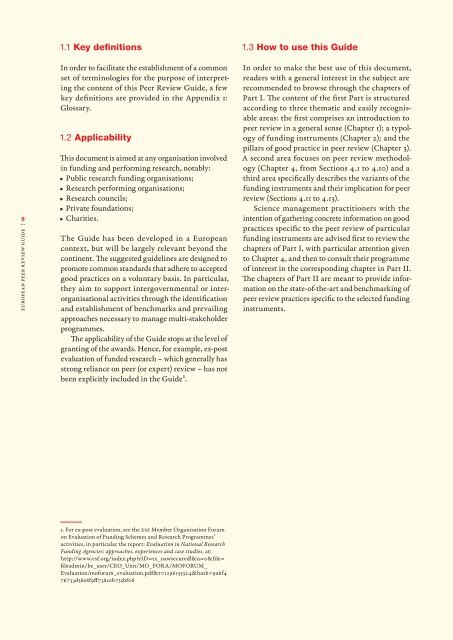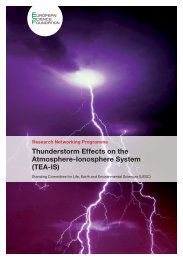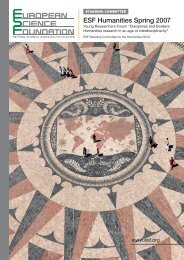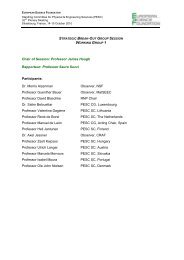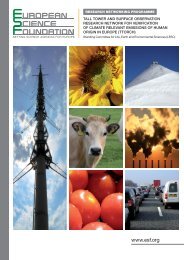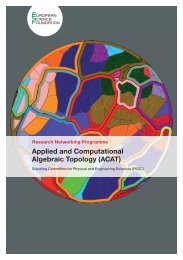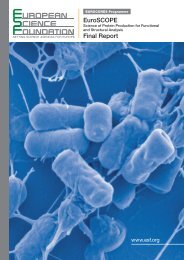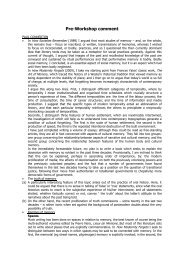European Peer Review Guide - European Science Foundation
European Peer Review Guide - European Science Foundation
European Peer Review Guide - European Science Foundation
Create successful ePaper yourself
Turn your PDF publications into a flip-book with our unique Google optimized e-Paper software.
1.1 Key definitions<br />
1.3 How to use this <strong>Guide</strong><br />
8<br />
<strong>European</strong> <strong>Peer</strong> <strong>Review</strong> <strong>Guide</strong><br />
In order to facilitate the establishment of a common<br />
set of terminologies for the purpose of interpreting<br />
the content of this <strong>Peer</strong> <strong>Review</strong> <strong>Guide</strong>, a few<br />
key definitions are provided in the Appendix 1:<br />
Glossary.<br />
1.2 Applicability<br />
This document is aimed at any organisation involved<br />
in funding and performing research, notably:<br />
• Public research funding organisations;<br />
• Research performing organisations;<br />
• Research councils;<br />
• Private foundations;<br />
• Charities.<br />
The <strong>Guide</strong> has been developed in a <strong>European</strong><br />
context, but will be largely relevant beyond the<br />
continent. The suggested guidelines are designed to<br />
promote common standards that adhere to accepted<br />
good practices on a voluntary basis. In particular,<br />
they aim to support intergovernmental or interorganisational<br />
activities through the identification<br />
and establishment of benchmarks and prevailing<br />
approaches necessary to manage multi-stakeholder<br />
programmes.<br />
The applicability of the <strong>Guide</strong> stops at the level of<br />
granting of the awards. Hence, for example, ex-post<br />
evaluation of funded research – which generally has<br />
strong reliance on peer (or expert) review – has not<br />
been explicitly included in the <strong>Guide</strong>1.<br />
In order to make the best use of this document,<br />
readers with a general interest in the subject are<br />
recommended to browse through the chapters of<br />
Part I. The content of the first Part is structured<br />
according to three thematic and easily recognisable<br />
areas: the first comprises an introduction to<br />
peer review in a general sense (Chapter 1); a typology<br />
of funding instruments (Chapter 2); and the<br />
pillars of good practice in peer review (Chapter 3).<br />
A second area focuses on peer review methodology<br />
(Chapter 4, from Sections 4.1 to 4.10) and a<br />
third area specifically describes the variants of the<br />
funding instruments and their implication for peer<br />
review (Sections 4.11 to 4.13).<br />
<strong>Science</strong> management practitioners with the<br />
intention of gathering concrete information on good<br />
practices specific to the peer review of particular<br />
funding instruments are advised first to review the<br />
chapters of Part I, with particular attention given<br />
to Chapter 4, and then to consult their programme<br />
of interest in the corresponding chapter in Part II.<br />
The chapters of Part II are meant to provide information<br />
on the state-of-the-art and benchmarking of<br />
peer review practices specific to the selected funding<br />
instruments.<br />
1. For ex-post evaluation, see the ESF Member Organisation Forum<br />
on Evaluation of Funding Schemes and Research Programmes’<br />
activities, in particular the report: Evaluation in National Research<br />
Funding Agencies: approaches, experiences and case studies, at:<br />
http://www.esf.org/index.php?eID=tx_nawsecuredl&u=0&file=<br />
fileadmin/be_user/CEO_Unit/MO_FORA/MOFORUM_<br />
Evaluation/moforum_evaluation.pdf&t=1296135324&hash=9a6f4<br />
76733d58e8f9ff738ceb755bf08


